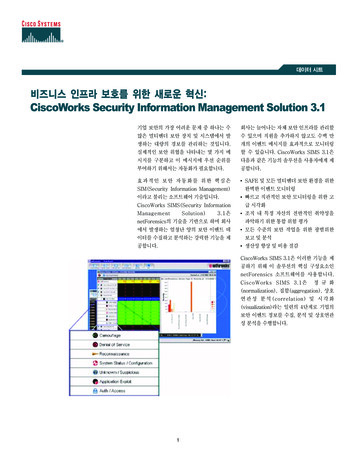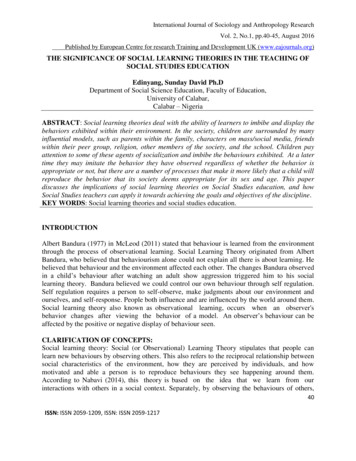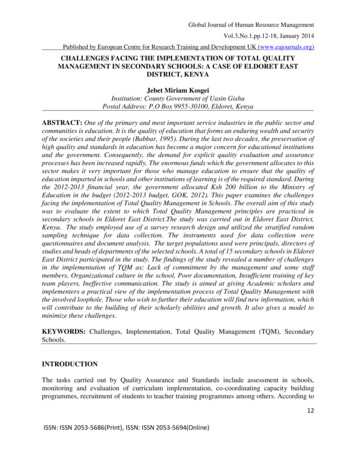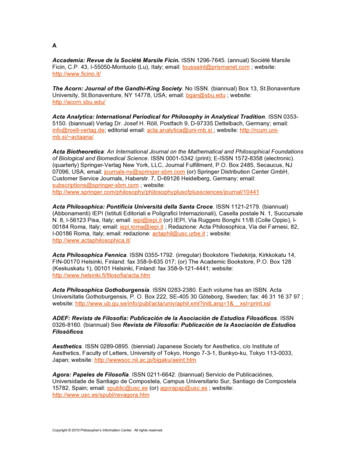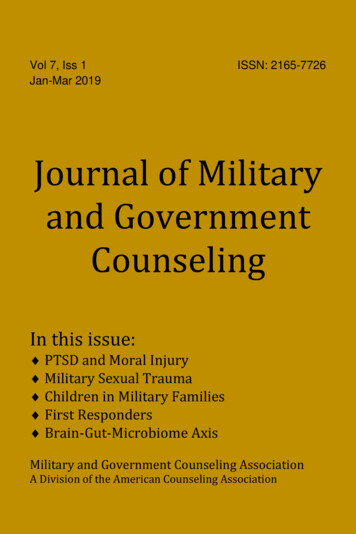
Transcription
Vol 7, Iss 1Jan-Mar 2019ISSN: 2165-7726Journal of Militaryand GovernmentCounselingIn this issue: PTSD and Moral Injury Military Sexual Trauma Children in Military Families First Responders Brain-Gut-Microbiome AxisMilitary and Government Counseling AssociationA Division of the American Counseling Association
Journal of Military and Government CounselingVolume 7, Issue 1 2019Letter from the EditorsThe Journal of Military and Government Counseling (JMGC) isan official publication of the Military and Government CounselingAssociation (MGCA), a division of the American CounselingAssociation. The mission of the journal is to promote reflection and toencourage, develop, facilitate, and promote professional developmentfor administrators, counselors, and educators working with all membersof the Armed Services and their families, whether active duty, guard,reserve, retired, or veteran; civilian employees of the Department ofDefense; first responders including EMS, law enforcement, fire, andemergency dispatch personnel; and employees of Local, State andFederal governmental agencies.Welcome to the latest edition of the JMGC. Starting with thisissue we will be expanding the JMGC’s offerings to include more anddeeper conversations that will help clinicians to better understand andwork with military and first responder personnel. We hope to expand ourprofessional perspectives so we can better understand how to work withand support these populations, their families, and their communities. Weintend to include perspectives that you may not expect, but that may(re)open our clinical eyes to the many perspectives that can be includedin this area of professional work.So, keep those manuscript submissions coming in and contact usif you are interested in being a reviewer for the JMGC. As always, thankyou for the work you do in support of our military, first responder andemergency service personnel, and those that work in and withgovernment agencies.The procedure for submitting articles is available at JMGCGuidelines for Authors ilitation-interpreter-training/jmgc/index.html) and the contactemail is JMGCEditor@troy.edu.The JMGC Editorial TeamISSN: 2165-7726
Journal of Military and Government CounselingVolume 7, Issue 1 2019The Journal ofMilitary and Government CounselingManaging EditorsKeith A. Cates, PhD, Associate Professor, Faculty and Clinical Director,Division of Counseling, Rehabilitation, and Interpreter Training, TroyUniversityLynn Boyd, PhD, Associate Professor, Faculty and Associate DivisionDirector, Division of Counseling, Rehabilitation, and Interpreter Training,Troy UniversityEditorial AssistantMichelle Zeller, BA, Clinical Mental Health Counseling program, Division ofCounseling, Rehabilitation, and Interpreter Training, Troy UniversityAdministrative EditorD. Andrew Creamer, PhD, Associate Professor, Faculty and Division Director,Division of Counseling, Rehabilitation, and Interpreter Training, TroyUniversityFounding Editor and Current Editor-in-ResidenceBenjamin V. Noah, PhD, Part-time Faculty, School of Counseling and HumanServices, Capella UniversityConsulting Technical Editor: Valerie CatesEDITORIAL REVIEW BOARDNicole Arcuri Sanders, PhD, CoreFaculty, School of Counseling andHuman Services, Capella UniversityWilliam J. Davis, Jr., PhD, Professor,U.S. Army Command and General StaffCollegeLarry Ashley, EdS, Educational andClinical Studies, Professor Emeritus ofCounseling, University of Nevada, LasVegasChristian J. Dean, PhD, Core Faculty,School of Counseling, Walden UniversityWilliam C. Attridge, PhD, Core Faculty,Dept. of Counseling, Capella UniversitySam Booker, PhD, Assistant Professor,Division of Counseling, Rehabilitation,and Interpreter Training, Troy UniversityAllen Delaney, PhD. ProgramDirector/Clinical Coordinator, SouthUniversityNeil Duchac, PhD, Assistant Professor,Department of Social Work and HumanServices, Kennesaw State UniversityISSN: 2165-7726
Journal of Military and Government CounselingJeri Ellis, EdD, Core Faculty, School ofCounseling and Human Services, CapellaUniversityDoreen Austin (DA) Erickson, PhD, CoreFaculty, School of Counseling andHuman Services, Capella UniversitySeth C. W. Hayden, PhD, AssistantProfessor, Department of Counseling,Wake Forest UniversityKrystal D. Humphreys, PhD, AssistantProfessor, Department of Counseling,Bethel UniversityJoseph W. Johnson, PhD, AssistantProfessor, College of Education, TroyUniversityKeith J. Myers, PhD, Assistant Professor,School of Counseling, RichmontGraduate UniversityVolume 7, Issue 1 2019Dannette Patterson, EdD, CoreCounseling Faculty, University ofPhoenix, Counseling/College ofHumanities and SciencesCatherine J. Stower, PhD, AssociateProfessor, The Chicago School ofProfessional PsychologyNikki Vasilas, PhD, Associate Professorand Clinical Coordinator of Counseling,Lenoir-Rhyne UniversityAngie Waliski, PhD, Assistant ResearchProfessor, University of Arkansas forMedical SciencesDaniel G. Williamson, PhD, Professor,Graduate Counseling Program,University of Mary Hardin-BaylorJennifer Williamson, PhD, Professor,Graduate Counseling Program,University of Mary Hardin-BaylorHeather Zeng, PhD, Core Faculty, Schoolof Counseling and Human Services,Capella UniversityThe Journal for Military and Government Counseling (ISSN: 2165-7726) is published quarterlyin March, June, September, and December by the Division of Counseling, Rehabilitation, andInterpreter Training (DCRIT) at Troy University and the Military and Government CounselingAssociation.Copyright 2019, Military and Government Counseling Association. All rights reserved.No part of this publication may be reproduced, stored, transmitted, or disseminated in any formor by any means without prior written permission from the Military and Government CounselingAssociation (MGCA) through the Division of Counseling, Rehabilitation, and InterpreterTraining at Troy University (DCRIT). The MGCA grants authorization for individuals tophotocopy copyright material for private research use on the sole basis for requests for such useare referred directly to the requester’s local Reproductions Rights Organization (RRO), such asthe Copyright Clearance Office (www.copyright.com) in the USA or the Copyright LicensingAgency (www.cla.co.uk) in the UK. This authorization does not extend to any other kind ofcopying by any means, in any for, and for any purpose other than private research use. Thepublisher assumes no responsibility for any statements of fact or opinion expressed in thepublished papers.Permissions. For further information, please contact the editor at JMGCEditor@Troy.eduMarch, 2019ISSN: 2165-7726
Journal of Military and Government CounselingVolume 7, Issue 1 2019Journal ofMilitary and Government Counseling1-31PTSD and Moral Injury in Clint Eastwood’s Flags of OurFathers and Gran TorinoJohn C. Fitch III, and Jason Bluemlein32-47“I Don’t Want to be the Scared, Broken Bird”: ProcessingMilitary Sexual Trauma Through Sandtray TherapyErin Kern Popejoy, and Kristi Perryman48-57Supporting Children in Military Families During the PreDeployment Stage: Operation Intervention and PreventionRebekah Cole58-76First Responders: Identity, Culture, and Challenges for MentalHealth Counseling ProfessionalsKeith A. Cates, Michelle M. Zeller,and Tamantha Anne Cumbie77-91The Brain-Gut-Microbiome Axis and its Impact on MentalHealth and Military PopulationsMichelle M. Zeller, Nicholas J. Trapp, and Keith A. CatesISSN: 2165-7726
Journal of Military and Government CounselingVolume 7, Issue 1 2019PTSD and Moral Injury in Clint Eastwood’sFlags of Our Fathers and Gran TorinoJohn C. Fitch IIIEastern Kentucky UniversityJason BluemleinUniversity of the CumberlandsDepictions of combat-related trauma in American motion pictures are oftencriticized as being over-simplified or stereotypical. Films that focus on thecauses and symptoms of trauma may add to the stigmatization of mentalhealth surrounding combat veterans and may affect the image of real-lifetreatment options. The differences between post-traumatic stress disorderand moral injury have not only been obscured in cinematic texts, but also inclinical practice. Relatively recent films by director Clint Eastwood presentopportunities for discerning between the two conditions. This paper offers adiscussion of PTSD and moral injury in two Eastwood combat films, Flagsof Our Fathers and Gran Torino. Clinical considerations andrecommendations for counselors, service people, and filmmakers are alsooffered.Keywords: PTSD, moral injury, motion pictures, counseling,militaryAddress correspondence to John C. Fitch III at john.fitch@eku.eduAmerican films have offered audiences depictions of war andwarriors since the inception of the medium in the late 1800’s. Featurelength fiction narratives, documentaries, and wartime newsreels havepresented the U.S. public with accounts of combat, defeat, victory,reintegration, and the return home. Whether propaganda, cautionary tales,or morality plays, American combat films have long occupied theISSN: 2165-77261
Journal of Military and Government CounselingVolume 7, Issue 1 2019imaginations of moviegoers, and their influence can be seen in a wide arrayof cultural texts – from video games to military recruiting materials.Alongside the heroic portrayals of triumphant warriors, Americanfilmmakers have painted compelling portraits of the mental and emotionalsuffering that can accompany the combat, coming home, and reintegrationexperiences. The extent to which these portrayals accurately reflect the reallife experiences of traumatized military personnel is unclear andcontroversial (Kauffman, 2016).Moreover, cinematic representations of combat trauma sufferershave been regularly criticized for their reliance on negative stereotypes andharmful exaggerations (Kauffman, 2016; Phillips, 2015; Satel & McNally,2013). Many filmic combat veterans have been presented as homicidal,suicidal, anti-social, psychotic, or vigilante characters that present a dangerto themselves and to society in general – especially if they appear to sufferfrom a trauma condition like PTSD (e.g. Taxi Driver, Brothers, Rambo:First Blood, The Deer Hunter, Coming Home, Jacob’s Ladder). Recently,such reductive characterizations have dwindled as more nuanced andsympathetic representations have become common (In the Valley of Elah,The Hurt Locker, Flags of Our Fathers, Saving Private Ryan). However,clinicians, filmmakers, the general public, and clients need more educationand clarification on how the realities and treatment of these conditionsdiffer from cinematic presentations. Further, more clarity on the topic mayprovide clinicians with opportunities to use cinematic texts in treatment andeducational settings – both as realistic examples, and as erroneous ones. Fortrauma and moral-based injuries, effective treatment is usually onlypossible with correct diagnosis, and the ability to differentiate between thevarious types of trauma-induced disorders – as presented both in real lifeand on screen – is a key capability for practitioners and veterancommunities (Dombo, Gray, & Early, 2013; Drescher & Foy, 2008).This paper presents a brief introduction to the existing literature onmoral injury among combat veterans, and how it differs from PTSD. It alsooffers an exploration of the various presentations of morally injuriousexperiences (MIEs) and PTSD in two of director Clint Eastwood’s films:Gran Torino (2008), and Flags of Our Fathers (2006), followed by a2ISSN: 2165-7726
Journal of Military and Government CounselingVolume 7, Issue 1 2019discussion of the differences between the film’s depictions and real-lifetherapeutic considerations. Recommendations for filmmakers, counselors,and the general public on confronting cinematic portrayals of combatrelated trauma are also included.PTSD and Moral Injury in FilmMuch of the academic literature on these “shell shock,” PTSD, or“coming home” films explores portrayals of psychologically andemotionally wounded military personnel (Gates, 2005; Muruzabal, 2008;Shewring, 2004) and documents the various ways such films portray thecauses and effects of combat-related trauma (Hankir & Agius, 2012;Katafias, 2015; Pinchevski, 2016; Safran, 2001). Since the Vietnam Warera, several combat-themed films have explicitly addressed wartime traumaand mental illness, and scholars have provided extensive commentary andanalysis from a number of perspectives (Brady, 2015; Cardullo, 2011;Hoelbling, 2014; Katzman, 1993; Maseda & Dulin, 2012; Noreen, 2004;Shay, 2002; Chapin, Mendoza-Burcham, & Pierce, 2017). However, todate, relatively little has been written about the distinctions betweentrauma-induced stress disorders like post-traumatic stress disorder (PTSD),moral injury, and morally injurious experiences (MIEs) as presented in warand “coming home” films.Yet, the recent work of filmmaker Clint Eastwood has spurred newdiscussions of both combat-related and civilian trauma (Hamilton &Redmon, 2017), and some authors have addressed the appearance of moralinjury and PTSD in his films directly. Most notably, Brown & Westbrook(2018), provide a seminal discussion on the portrayal of moral injury inseveral of Eastwood’s films, including Gran Torino, Flags of Our Fathers,and Heartbreak Ridge (1986). Other manuscripts include Scott’s (2017)examination of delayed combat trauma and MIEs surrounding the maincharacter in Clint Eastwood’s Gran Torino. Similarly, Brown andWestbrook (2017) explore the exacerbation of moral injury among soldiercharacters in Flags of Our Fathers, and Gjelsvik (2013) discusses how themoral and ethical dimensions of killing in combat are confronted in thatfilm and previous American combat films.ISSN: 2165-77263
Journal of Military and Government CounselingVolume 7, Issue 1 2019Manm (2013) examines how the unique narrative structure anddiscontinuous editing of Flags of Our Fathers reinforces the impressionthat the main characters’ past experiences continually haunt the presentrealities – a phenomenon commonly observed in PTSD (Drescher & Foy,2008). However, few of these projects have offered details on the clinicallyrelevant distinctions between MIEs and PTSD in Eastwood’s combat films,nor have they explored the dissonance between reality and cinematicprojections. Two of Eastwood’s trauma films, Flags of Our Fathers andGran Torino, provide opportunities for an analysis of the subtle differencesbetween these two phenomena, as well as the difference between cinematicand real-life presentations and treatments of such disorders.PTSD, Moral Injury, and Morally Injurious ExperiencesPractical distinctions between PTSD and moral injury are fairlynew. While PTSD has been formally recognized as a psychiatric disorder inthe U.S. since 1980, the clinical literature on moral injury dates to 2009(Litz et al., 2009). Morally injurious experiences (MIEs) are oftenunderstood as combat-related events that may cause moral injury. However,the terms, MIE and moral injury are used interchangeably (Lancaster &Harris, 2018). PTSD has been recognized as a phenomenon for centuries,but when the American Psychiatric Association included it in theDiagnostic and Statistical Manual of Mental Disorders (DSM-III) in 1980,the treatment and scientific communities had a codified disorder, ratherthan a loose set of symptoms, to both study and address (see Appendix).Treatment for PTSD remains difficult, and a number of interventions havebeen recommended and tested (McLean, et. al., 2018; Schmuldt, et. al.,2013; Wilson, Friedman, & Lindy, 2012), and specific treatments for PTSDassociated with moral injury are being investigated (Held, Klassen,Brennan, & Zalta, 2017). However, the scientific research on moral injuryand MIEs is still emerging, and moral injury is widely considered atheoretical construct, not an official diagnosis (Litz et al., 2009; Maguen &Litz, 2012).While many of the symptoms of the two conditions overlap, thecrucial differences between PTSD and moral injury are gaining attention4ISSN: 2165-7726
Journal of Military and Government CounselingVolume 7, Issue 1 2019(Drescher, et. al., 2011; Koenig, 2018). PTSD is defined as a stress-relatedpsychiatric disorder caused by a single or several traumatic events thatcauses the sufferer to experience a number of troublesome symptoms,including “intrusive recollections, avoidant/numbing symptoms, and hyperarousal symptoms” (Friedman, p. 1). Moral injury is defined as a conditionthat arises from “an act of serious transgression that leads to serious innerconflict because the experience is at odds with core ethical and moralbeliefs” (Maguen & Litz, 2012, p. 1). Symptoms include shame, guilt, selfhandicapping behaviors, self-harm, withdrawal, and self-condemnation (seeAppendix). Some researchers and clinicians maintain that effectivetreatment of both disorders may require recognition of the distinctionsbetween them, and that the usual treatments for PTSD may not always beeffective for the treatment of moral injury (Maguen & Litz, 2012). In fact,moral injuries and MIEs may exacerbate existing PTSD symptoms andcomplicate treatment for sufferers. (Currier, Holland, & Malott, 2015).Recognizing the distinctions between the two may help providers,researchers, clinicians, and sufferers improve treatment outcomes forsuffering veterans. Further, understanding these distinctions may assistfilmmakers and other storytellers in constructing realistic renditions.The FilmsThe Clint Eastwood films selected for analysis and discussion areGran Torino and Flags of Our Fathers. Gran Torino was released in 2008,winning several awards, an enthusiastic foreign and domestic reception, anda profit of nearly 120 million. The film follows the late life journey ofWalt Kowalski (played by the director), a Korean War veteran who retiredfrom a large American auto plant and settled into a now declining Detroitsuburb. Flags of Our Fathers (2006) had a higher production budget thanGran Torino and grossed only 65 million, but it was well received byaudiences and critics alike. Based on a popular non-fiction book, the filmpresents the real life story of the soldiers who raised the battle flag on IwoJima in World War II and were captured in an iconic photograph.These films were chosen for three reasons. First, both featurecombat service people as main characters who display behaviors associatedISSN: 2165-77265
Journal of Military and Government CounselingVolume 7, Issue 1 2019with moral injury and PTSD. Second, while recent scholarship has focusedon these particular cinematic portrayals of combat trauma (Brown &Westbrook, 2018; Gjelsvik, 2013; Manm, 2013; Scott, 2017), there iscurrently no published research on these two films from a counseling pointof view. Third, since these films are relatively recent, successful, andaward-winning productions by a famous filmmaker, the films may be moreaccessible to members of the general public, counselors, and clinicalpopulations than older or lesser known titles. For this paper, the two filmswere repeatedly viewed and specific scenes and actions that containeddepictions of traumatic events, trauma-induced behaviors, and dialoguewere identified. Using criteria for symptoms and causes of moral injuryestablished by Litz et al., (2009), and PTSD symptom clusters as identifiedby the U.S. Department of Veterans Affairs National Center for PTSD andthe Mayo Clinic (see Appendix), three of the films’ main characters wereconsidered to be suffering from one of the two conditions. A detailedanalysis of several selected scenes and a discussion of their apparentsymptoms follows.Gran TorinoWhen Walt Kowalski first appears in Gran Torino, his wife has justpassed away, and the elderly retiree is left alone. His few social contactsconsist of his ungrateful sons and their spoiled children, the local priest, hisdog, and a few drinking buddies at the VFW hall. Within the first fewscenes, Walt begins to present behaviors that align with most of the criteriaassociated with moral injury: shame, guilt, self-handicapping behaviors,self-harm, withdrawal, and self-condemnation (Drescher & Foy, 2008; Litzet al., 2009). Early in the film, a Catholic priest who delivered the eulogyfor Walt’s wife, Father Janovich (Father J.), appears in the VFW hall whereWalt is drinking with a few other men. After a few friendly barbs with thegroup, the priest asks Walt to join him at a nearby table for a chat. Havingpromised Walt’s wife that he would look out for Walt after she passed,Father J. now pressures Walt to go to confession as per the wife’s dyingwishes. Walt mocks the young priest’s nascent experience, and then makesa type of confession after Father J. asks him what he knows about death.6ISSN: 2165-7726
Journal of Military and Government CounselingVolume 7, Issue 1 2019Walt: I know a lot. I lived for almost three years in Koreawith it. We shot men. Stabbed them with bayonets, hacked 17year-olds to death with shovels. Stuff I’ll remember till theday I die. Horrible things, but things I’ll live with (Eastwood,2008).Walt recounts his wartime experiences with a sense of shame andguilt, and laments the “horrible things” he still carries (Eastwood, 2008).Although he appears to be proud of his service, the moral revulsion heexpresses when recounting these actions is palpable. After this monologue,the priest presses him about his knowledge of life. Walt can only mustertwo things: that he survived the war, and that he created and sustained afamily. He then admits that he might know more about death than life.Walt’s struggle with the regret that accompanies his shame andguilt is again on display just a few scenes later. Father J. comes to his houseafter hearing about the attempted theft of Walt’s Gran Torino and the elderveteran’s fruitless attempt to punish the would-be thief. Father J. is angrythat Walt didn’t call the police and that he tried to shoot the burglar with hisold service rifle. The two argue briefly over the incident, and Father J.makes another attempt at getting Walt to confess.Father J: I’ve been thinking about our conversation on lifeand death. About what you said. About how you carry aroundall the horrible things you were forced to do horrible thingsthat won’t leave you. It seems it would do you good to unloadsome of that burden. Things done during war are terrible.Being ordered to kill. Killing to save yourself. Killing to saveothers (Eastwood, 2008).Father J. continues his diatribe, invoking the redemptive andhealing power of confession and forgiveness, saying that men who have“admitted their guilt” are relieved of their burdens. He says that even menwho have done “appalling things” are now at peace (Eastwood, 2008).Walt’s response attests to the intrusive and abiding nature of his own guiltand shame:ISSN: 2165-77267
Journal of Military and Government CounselingVolume 7, Issue 1 2019Walt: And you’re right about one thing: about stronger menthan me reaching their salvation. Well, halle-fucking-lujah.But you’re wrong about something else.Father J: What’s that, Mr. Kowalski?Walt: The thing that haunts a man the most is what he isn’tordered to do (Eastwood, 2008).Here, Walt sets himself apart from the combat veterans who wereable to attain absolution for their wartime “sins.” He suggests that he isdifferent; that his self-directed, voluntary brutality has outpaced even divineforgiveness. The implication that he performed acts of savagery beyond theorders of his superiors – that he killed and maimed even when not orderedto do so – reflects not only significant guilt, but also another symptom ofmoral injury: self-condemnation (Litz et al., 2009). Walt later providesfurther indications of his denigrating self-assessment.As the film progresses, Walt is slowly drawn out of his selfimposed isolation and withdrawal through his friendship with the Hmongfamily that lives next door. After saving the young Hmong man (Thao)from a certain beating and possibly death at the hands of the local gang, andthe teen girl (Sue) from a few street punks, the neighbors shower him withgifts of food and flowers. When Sue invites him to a Hmong party on hisbirthday, Walt attends just for the beer and food, but is drawn deeper intothe family when the resident shaman, Kor Khue, “reads” him at the party.At one point during the reading, the shaman tells Walt that he “made amistake in your past life, like a mistake that you did you’re not satisfiedwith” (Eastwood, 2008). As Kor Khue finishes his reading, Walt looksshaken. He gets up from his chair, walks out of the room and into the diningroom where he watches the Hmong women serve each other tea. A bitashen, and with a fearful look on his face, Walt begins to cough. When Sueasks him if he’s all right, she notices that he’s coughing up blood. Walt thenruns up the stairs and lurches into the bathroom where he coughs into thesink. His response to the shaman’s reading and the mention of the “pastmistake” may be a psychosomatic reaction caused by his feelings of shameand/or guilt. Perhaps Kor Khue’s reference to a “mistake that he did” in apast life stirred memories of Walt’s violent actions in Korea, suddenly8ISSN: 2165-7726
Journal of Military and Government CounselingVolume 7, Issue 1 2019making him feel sick (Eastwood, 2008). In fact, Walt’s long-term selfcondemnation could have significantly contributed to a chronic illness. Thiskind of physiological reaction and the detrimental long-term healthoutcomes that accompany it is common among traumatized veterans whostruggle with reintegration (Kaplan, 1997; Worthington & Langberg, 2012).As the film enters the third act, Walt’s friendship with Sue andThao continues to deepen, and by the ninety-minute mark, they are alltogether at Walt’s house, picnicking while Walt happily drinks beer. AsThao washes the beloved Gran Torino in the background, Sue recounts allof the good things that Walt has done for her and her brother, closing with afirm statement.Sue: [about Thao] You like him don’t you?Walt: Are you kidding? He tried to steal my car.Sue: Uh-huh, and you spend time with him, teach him how tofix things, saved him from that fucked cousin of ours Walt: Hey! Watch your language, lady.Sue: And you’re a good man.Walt: I’m not a good man (Eastwood, 2008).Walt then quickly changes the subject, looking down uncomfortablyat his empty beer. Although he does not refute or deny any of the otheraccounts of his generous actions, he will not admit that he is a good man.This scene underscores the self-condemnation and shame that accompaniesWalt’s moral injuries. He forgave Thao for trying to steal his car, taughthim how to do construction work, and got him a job. But it’s not enough.Just as he believes that he is beyond forgiveness by God, he is so ashamedof what he’s done in the past that he cannot accept that his young friend andher brother see him as intrinsically good.Later in the film, Sue is raped and beaten by the Hmong gang andWalt, Father J. and Thao struggle with their response. Thao is bent onrevenge and begs Walt to join him in finding and killing the rapists. Walttells Father J. that he will “think of something,” and that the gangsters“won’t have a chance” (Eastwood, 2008). When Thao confronts Walt abouthis lack of action, Walt urges him to stay calm, saying that without calm,“mistakes get made” (Eastwood, 2008). Perhaps Walt is alluding to hisISSN: 2165-77269
Journal of Military and Government CounselingVolume 7, Issue 1 2019mistakes in combat – those things that haunt him. Thao wants revenge rightaway, but Walt forces him to sit and wait for a well-developed plan.Thao: I say we go now. Right now.Walt: And what? Kill that cousin of yours and the rest of those zips?Mr. Tough Guy out for blood all of a sudden? You know nothingabout it (Eastwood, 2008).Walt clearly does not want to kill again, but he admits that neitherThao nor Sue will have true peace until the gangsters are “gone forever”(Eastwood, 2008). Walt then goes to work on a kind of “bucket list.” Hetakes a bath, gets a haircut, smokes in the house (instead of on the porch),gets the first shave of his life with a straight razor, mows the lawn, gets hissuit fitted by a tailor, and goes to Father J. for the long-awaited confessionwhere he admits to a few peccadillos but says nothing about the war. Walt’strue confession comes in the next scene as he gives Thao his Silver Starmedal in the basement while telling him the story of the action that earnedhim the recognition.Thao: How many men did you kill in Korea?Walt: Thirteen. Maybe more.Thao: What was it like to kill a man?Walt: You don’t want to know (Eastwood, 2008).Walt then tricks the boy and locks him in the basement so that hecan’t accompany Walt on his mission. Here, we get the full account of theincident that caused Walt’s moral injury.Walt: You wanna know what it’s like to kill a man? Well it’sgoddamn awful, that’s what it is. The only thing worse isgetting a medal of valor for killing some poor kid that justwanted to give up, that’s all. Yeah, some scared little gookjust like you. I shot him right in the face with that rifle youwere holding in there a while ago. Not a day goes by that Idon’t think about it, and you don’t want that on your soul.Now I got blood on my hands. I’m soiled (Eastwood, 2008).In this scene, Walt’s language aligns with the many of thesymptoms of moral injury and contributing factors in MIEs. He is ashamedand feels guilty not only for killing, but also for being rewarded for doing10ISSN: 2165-7726
Journal of Military and Government CounselingVolume 7, Issue 1 2019so (Drescher et al., 2011). He continues to condemn himself – he ispermanently soiled and has blood on his hands (Shay, 2002). He is beyondrepair as he has violated a number of social conventions (Nash & Litz,2013). Additionally, his injury may be made worse by the fact that he feelsbetrayed by himself, his commanding office
School of Counseling, Walden University Allen Delaney, PhD. Program Director/Clinical Coordinator, South University Neil Duchac, PhD, Assistant Professor, . Jason Bluemlein University of the Cumberlands Depictions of combat-related trauma in American motion pictures are often


